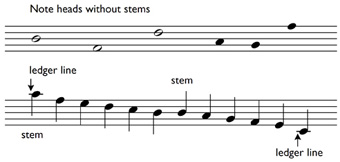2.5 Writing notes
Although much of the note-writing in Inside music involves using the software package, Sibelius First, it is worthwhile considering briefly the conventions used when writing staff notation by hand on manuscript paper (the name for pages with staves printed on them). Fundamentally, when writing music, you are trying to communicate with a reader and legibility is therefore important.
You should bear in mind the following guidelines when writing notes on paper.
- Note heads are oval in shape (some open, some filled in – we’ll see the reason for this later) and should sit centrally on a line or in a space so that no confusion can arise as to the pitch notated.
- Most notes also need stems, and these should be vertical and should be roughly the same height as the height of the staff.
- In addition, note stems should go down on the left-hand side for note heads on the top two lines of the staff and in the top two spaces, and up on the right-hand side for note heads on the bottom two lines and in the bottom two spaces. Stems for note heads on the middle line can go up or down.
- Ledger lines should run parallel to the lines of the staff.
Example 11 provides examples of these points.
Example 11

